Once a year or so, I like to talk about some of my audio interests. “Audio” means the machines that make music in your home.
I generally regard this as a sort of dormant hobby. It’s something I play around with intermittently, perhaps when I have a little free time in the schedule. I don’t take it too seriously. Nevertheless, a lot seems to have happened since the beginning of 2013.
January 13, 2013: Audio 2013
June 21, 2009: Summer Slack-Off 1: Headphone Audio
August 24, 2008: Five Audio Systems
July 15, 2007: Give Yourself the Gift of Music
Big advancements and discoveries:
First, I upgraded my DAC (Digital/Analog convertor) to the awesome Metrum Octave. I have the first generation version, which is going cheaply these days on the used market. This is a “no-oversampling R2R” DAC, of which there are only a few models made, unlike the thousands of models of “delta-sigma” DACs. Better yet, it uses some sort of unidentified signal-processing IC (integrated chip) that is not one of the usual out-of-production DAC ICs you usually see in these things.
I haven’t heard all DACs, or even a few, although a friend of mine does have a nifty EMM Labs model ($). I prefer the Metrum. It has a sonorous tonality that really goes along with my other DHT SET gear, based on vacuum tubes from the 1930s. Lynn Olsen wrote an extended essay in 2012 about R2R architecture, which gives some idea of what I mean:
http://www.positive-feedback.com/Issue65/dac.htm
http://www.positive-feedback.com/Issue66/dsd.htm
Here’s a bit from Lynn Olsen’s first essay:
I’ve been listening to the latest round of delta-sigma DACs—at substantial price points of more than $6000—and for reasons I don’t completely understand, they sound alike, and quite different than the $1100 Monarchy N24 that I’ve had for the last ten years. The technologies are pretty different: the N24 uses the TI/Burr-Brown PCM1704 ladder/R-2R converter, passive current-to-voltage conversion, with zero-feedback vacuum-tube amplification. …
The delta-sigma DACs I’ve been auditioning use a completely different architecture; delta-sigma chips from Crystal Semiconductor, Analog Devices, and the ESS Sabre 9018, along with all-solid-state electronics. Some of these use opamps, some discrete FETs and bipolar transistors, but they all have a common sound—what I’m beginning to think of as the “delta-sigma” sound.
What’s going on here? I hear it in my iPod Touch driving Sennheiser HD580 headphones, I hear in my Marantz AV8003 pre-pro that I use for movies, and I hear it in the latest group of DACs. Yes, they all sound modern and up-to-date; smooth, pleasant, free of the grit-and-grain that plagued early digital, and play 88.2, 96, and 192 kHz digital with the greatest of ease. But there’s something missing. I don’t have any fancy audiophile words for it, but it’s an absence of life, of sparkle, of that intangible sense of being right in the room with the performer.
If a singer in singing right at the ragged edge of their vocal range—and doing it intentionally to create a sense of tension—it is (much) less noticeable with DACs using delta-sigma chipsets. The impression of physical texture—a hand lightly brushing across the head of a drum, the sensation of wood and steel and weight from a grand piano, the odd and fascinating tonal meanderings of an oboe—is diminished or absent. In the highest-quality DAC with the ESS Sabre 9018 converter, it’s subtle, and takes a quick comparison with the PCM-1704 DAC to hear the difference. In the most other delta-sigma DACs, the loss is not subtle at all, and the performers sound bored, like they’re just phoning-in the performance. The nuances and over-the-top aspects are absent, replaced by a sort of monotone quality.
After a while, I kind of get used to this sound—the audiophile virtues of clarity, dimension and smoothness are certainly all there with the best of the high-end DACs—but then switch back to the Monarchy using the Burr-Brown PCM-1704 DAC and go “AH!”. All the vividness and tone color suddenly returns, and the performers, instruments and hall-space sound real again.
After several weeks of this, I started to wonder. What’s going on here? Is this just me? Have my tastes gotten so idiosyncratic I’ve completely departed from the mainstream of audio? Well, no.
Karna [his wife] hears the same thing too, just not using the high-falutin’ audiophile language I use. She thinks my setup (with the Monarchy N24) sounds “live”, like a performance right in front of you, while the others might be “accurate” as audiophiles understand it, they don’t sound “live”—they sound canned, electronic, recorded, not real. She thinks—and I have to agree 100% – that audiophiles have it all wrong with this obsession with “accuracy”. The so-called “accurate” systems almost never sound “live”—they mark all the tick-boxes on a checklist, but they just don’t sound like real performers playing real instruments in a real space.
This corresponded with my experience exactly, going from a well-regarded delta-sigma design to the Metrum. The Metrum upgrade really inspired me to fool around more. My headphone amplifier, which had been rather crabby, got a rebuild. Plans sort of changed in mid-rebuild, and it ended up for now as something not very often seen: a one-stage DHT headphone amplifier, using the 71A tube. I am able to do this by using the low 82 ohm output impedance of the DAC to drive my Sowter transformer volume control in reverse, using it as a stepup transformer. Since the Metrum also has no output stage, rather like the original TDA1543 Kusunoki design, that means we go from DAC output to headphones in one DHT stage. I’m not necessarily saying this is better, and in fact I plan to eventually add back the 01A gain stage because I might like it better than the stepup strategy. But, it is pretty good as it is, good enough that I am not real anxious to fool around with it, but would rather just sit back and listen.
Here’s more on the difference between R2R and Delta-Sigma architecture, from Audio Note Kits:
http://ankaudiokits.com/DAC-RR2-Part1.pdf
The actual conversion process from digital to analog is very critical” and this is what is at the heart of any DAC – Now listen closely! there are two major methods of accomplishing this conversion from digital information stored on a computer or a disk – the original method and the one currently used by AudioNote today along with a few other manufacturer’s is by “hardwiring” the digital numbers through an electrical circuit made up of resistors ,voltages & currents and basically outputting a voltage driven directly from the input – as the digital numbers change at the input of our circuit the output voltage changes – This method is referred to as a Resistor Ladder DAC or R2R. Its straightforward – no filters on the digital or analog fronts, no mucking with the signal – just pure conversion! Of course there are complexities in the precision resistors and the finer points of the circuits and the number of bits but bottom line is that it’s a direct HARDWIRING of digital numbers to actual output Voltage. For an audiophile level DAC this is correct strategy! END OF STORY!
The second method of performing this critical conversion is through computer horse power – basically the computer hardware reads in the first bit of data and continues to read in bits and analyze via complex mathematical algorithms, digital signal processing , quantization , dither , noise injection & feedback and the computer will determine a voltage that has been carefully computationally arrived at – This is referred to as a SIGMA DELTA – Now you may think that this is not a very good process compared to good old fashioned hardwired R2R – but the truth is that this computer processing method has many advantages – It is inexpensive compared to its R2R counterpart & very convenient for many musical applications : Internet radio, Home theater, 5 or 7 channel movies with surround sound, Mp3, IPODS, digital video cameras , even SACD uses this method , etc.etc.. ! It allows for great versatility and filtering and sound shaping , room correction etc – incredible flexibility and for 99.5% of the music world – SIGMA Delta is a great way to go!!!! – its cheap – ( Seen the cost of many 24/96 and 24/192 and 384Khz sampling DAC’s!) – ( SIGMA DELTA DAC’s love hi res formats cause its easy peasy to process them compared to R2R) its easy to mfg chips with tons of processing on them now a days- SIGMA DELTA dacs are here to stay! – Even companies like Analog Devices that made a range of R2R DAC chips in the 90’s now have a complete suite of SIGMA DELTA chips with tons of features! Basically all home theater gear, CD players, video cameras etc.etc. will use sigma delta processing. In fact virtually all modern DAC’s that are being made are SIGMA Delta based to handle the 24/192 supposedly HI-RES formats.
So why did Manufacturers start to move away from R2-R chips that they developed in the 90’s – Well basically it is an expensive process to create Integrated circuits with laser trimmed precision resistors on them to correctly implement the R2-R circuit – Its much easier to throw a few million gates at the problem! The Analog Devices AD1865 chip used in the AudioNote DAC’s is the highest bit resolution DAC chip that was made with 18 bits that results in 108db of potential dynamic range – So basically when you put a 24/96 signal through an AudioNote DAC you have a potential dynamic range capability of 108db which is approaching twice the dynamic range ever recorded! OK lets get back to our question here in deciding which DAC is right for you .
So which is the right DAC for you ? R2R or Sigma Delta ??– Well if you are reading this as a somewhat interested audiophile then I would highly recommend R2R for the utmost sonics in your system!
To summarize, the delta-sigma architecture uses a sort of feedback around what amounts to about a six-bit processing core. Lynn Olsen has much more detail. It seems like a lot of reviewers and others can’t really hear the difference between the R2R and delta-sigma architecture. Why not? Olsen hypothesizes that it is because they have other feedback-containing elements elsewhere in their system, which masks the difference. I agree with this completely. I had a nice headphone amplifier, with a 6880 cathode-follower output using solid-state current sources (a feedback-containing device) on both the gain and output stages. With my delta-sigma DAC, I couldn’t tell a lot of difference between this and my 71A amp. Yes, the 71A was better, but not a lot better, and I was thinking of retiring it as it is really a lot of fuss and bother. However, with the R2R-based Metrum, there was a HUGE difference between the 71A amp and the feedback-containing one. The no-feedback Metrum really displayed the difference between the two amps — and the no-feedback 71A amp really displayed the difference between the Metrum and the delta-sigma design, which was not so apparent on the 6880-based amp. In other words, any feedback anywhere in the signal chain seems to cloud these differences. Olsen suggests that one reason this difference is so obvious to him is because his own signal chain doesn’t contain feedback, including things like current-source loads and active power supplies.
The 6880-based headphone amp is sold now, along with my delta-sigma DAC. Going forward, I am a no-feedback-anywhere guy.
Olsen had another neat idea: that one either listens to the natural sound of the device, or the natural sound of the topology. In other words, if you have feedback, as is practically required when using power pentodes and transistors due to their current-amplifying nature, then you are listening to the nature of that feedback, well or poorly executed. If you have no feedback, then you are listening to the natural response of the transducer, in this case a vacuum tube or transistor. Among transducers, the 1930s DHTs and 1940s low-transconductance IHTs (such as the 6SN7) are among the best ever made, in measurable distortion, whether used in single-ended or Class A push-pull arrangements. Beginning in the 1950s, transducers (pentodes and high-transconductance triodes such as the 6DJ8, and eventually transistors) became a lot messier — and cheaper to produce — which was OK due to the use of global and local feedback also beginning in the 1950s, which in turn buried all these flaws within the nature of the topology itself. To make a long story short, no-feedback approaches and 1930s DHTs go together like peanut butter and jelly.
I also installed Audirvana, which is some inexpensive software to feed a digital signal via USB from my Mac to the Metrum DAC, instead of using iTunes. It was not a small improvement. It was huge. Use this.
On the headphone front, a friend generously let me borrow his top-of-the-line Sennheiser HD800 headphones for a number of weeks, so I could compare to the much cheaper HD600 models from the same company, my usual cans for over a decade. In those days, the HD600 was regarded as one of the best and most ambitious headphones on the market, but the $1000+ high-end headphone space has expanded a lot in recent years. Surprisingly, I preferred the HD600. The HD800 has much better build quality, and has a rather different presentation with a strong sense of spaciousness. However, the HD600 had a tone and directness that I really liked, and preferred. I think that, like the Metrum DAC, it requires very good electronics — the 71A headphone amp — to bring this out. Otherwise, you would probably prefer the more obvious virtues of the HD800. But, I felt the HD800 clouded over the tone intensity of the DAC and amp, which is another way of saying that I got less of a sense of emotional immersion into the heart of, for example, a vocalists’ performance. This sense of “tone” is the most important thing to me today. It has a lot of elements to make it work right.
The Audirvana/Metrum/71A amp combo is really magic.
Along the way, I was getting an urge to build speakers. This is partially because of my two-year-old, who really likes music. I wanted to show him what music is supposed to sound like. He doesn’t like headphones. Also, one of my audio friends was enthused about my prior history as a big horn nut, and I kinda wanted to show him what that was about too.
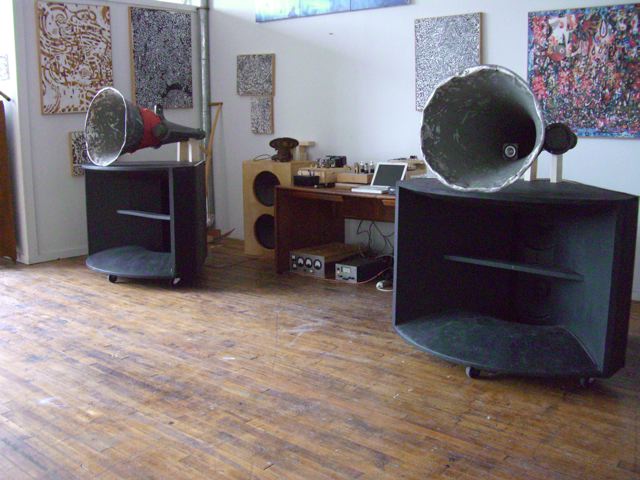 My big horn days circa 2008. The RCA MI-9462 “Ubangi” bass horns were from Jonathan Weiss’s Mill in Pennsylvania. They later found a home in Hong Kong.
My big horn days circa 2008. The RCA MI-9462 “Ubangi” bass horns were from Jonathan Weiss’s Mill in Pennsylvania. They later found a home in Hong Kong.
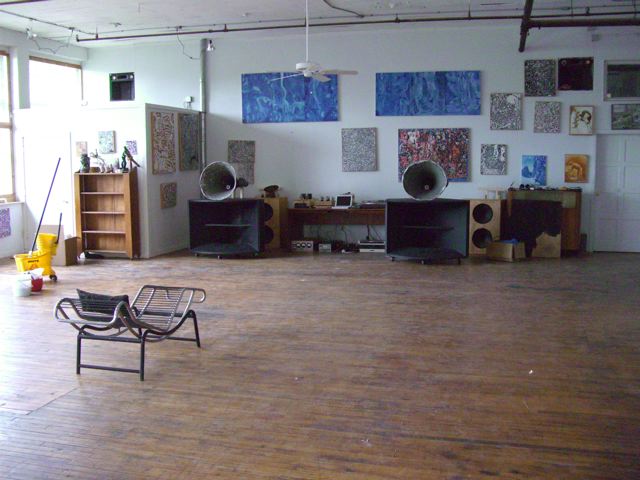
I had a big room in those days. It used to be a shoe factory.
It takes a big speaker to fill a room like this.
(It looked a lot nicer after I mopped the floor.)
This was one thing that impelled me to go visit Jonathan Weiss at the Oswald’s Mill Audio showroom in Brooklyn. I wanted to find out what was possible.
November 17, 2013: Audio 2013 2: My Visit to Oswald’s Mill Audio (OMA) in Brooklyn
Chris Sommovigo, an audio equipment manufacturer and serious enthusiast for over twenty years, recently wrote about his own experiences at the OMA showroom. Read it to get an idea of what I’m talking about.
http://thehighfidelityreport.com/down-the-rabbit-hole/
http://thehighfidelityreport.com/down-the-rabbit-hole-part-2/
The music unfolded and immersed me in some of the most outrageously delightful beauty I had ever experienced. It wasn’t really parseable by the same old laundry-list of audiophile litmus tests. Once you finished with the checklist there would still be so much more left over to deal with.
A complex sweep of emotion and thought hurried past my stunned synapses … I was sort of sad that I had spent the last 20 years chasing mere shadows and calling them “real” … this wasn’t subtle, wasn’t modest, and certainly wasn’t “audiophilic” at all. The “High End Audio” industry now seemed sallow and fading, with a Groundhog Day-like sameness, year in and year out, show after show, showroom after showroom, review after review of ported box after ported box …
Yep.
This visit was rather inspiring, although daunting because I know what a major project a big horn system is. I even bought some B&C DCX50 drivers — designed by Bill Woods and inspired by the RCA MI-1428 that also inspired the Cogent DS-1428 fieldcoil drivers used in the Imperia. A friend of mine who has both the DCX50 and the DS-1428 says that sometimes he can’t really tell the difference, or if he can, it isn’t important. I intend to eventually put them in some big horns.
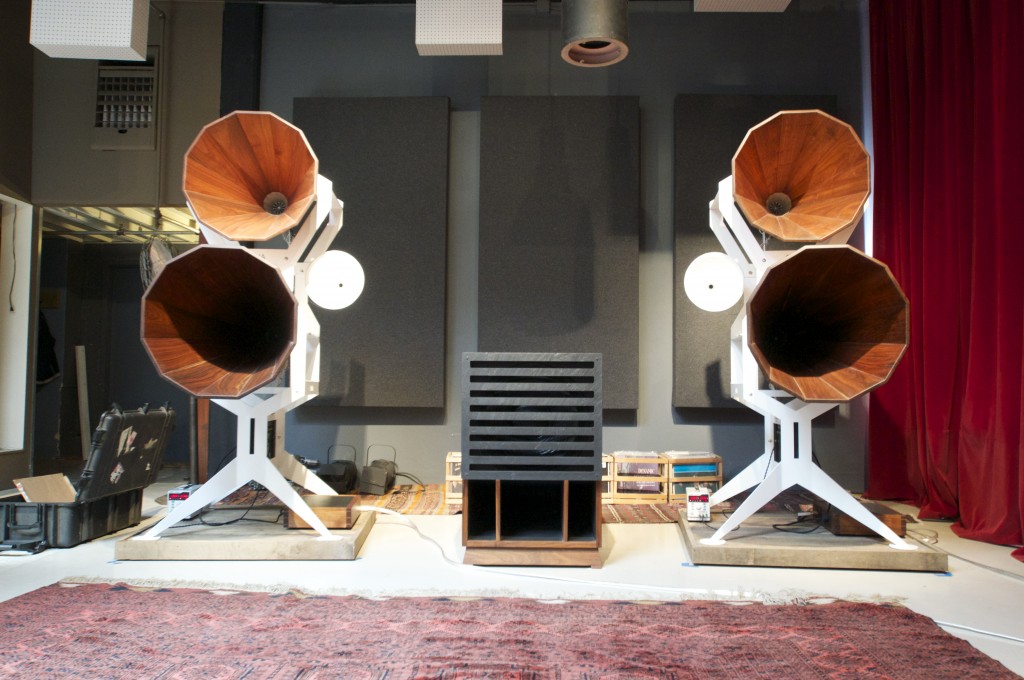
Jonathan Weiss’s Imperia system in Brooklyn.
But, my first step was to dig out of the barn some gear I’ve had for a while. This is some really odd kit: a 5.5′ long exponential horn designed as a standalone voice speaker for things like speeches and train stations. It dates from around 1936. The drivers are Western Electric 720A from the 1940s. The 720A is basically a permanent-magnet version of the famous WE555 that now sells for $8K+. It has the same basic parameters, and I’ve heard that you can even use the diaphragms as a drop-in replacement in the 555, although they are of phenolic design rather than duralumin.
In other words, you could put these drivers on a WE15A horn and use them down to about 60hz, just like a 555. They are designed for nearly full-range use. The tradeoff is power handling; they can’t handle more than about five watts. But, that is fine with me since I am using them with 3 watt Welborne 2A3 amps, actually wired for 1.5 watts in this case (the 8 ohm 720As are wired in series for 16 ohms, and used on the 8-ohm amp outputs). This would limit the max power for any one driver to 750 milliwatts, which I think is a good thing as it makes overdriving them near-impossible. It would not be an easy thing to replace these diaphraghms, and the drivers are actually quite valuable now.
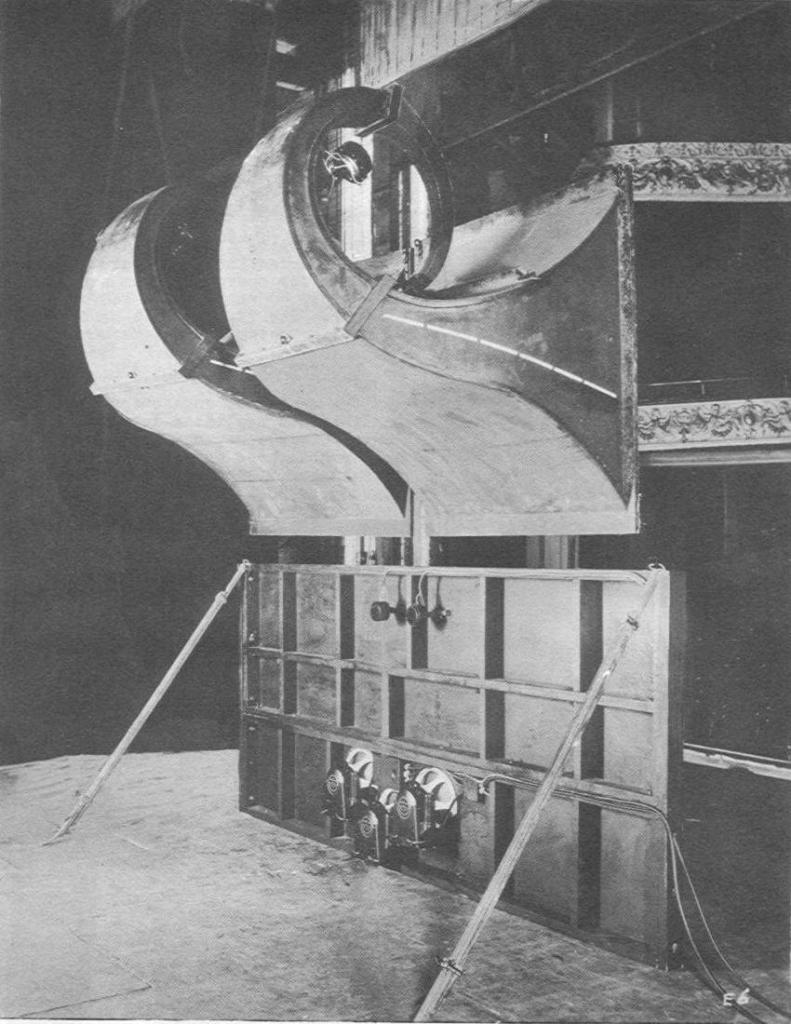
The speaker that made “talking pictures” possible in the 1930s: the Western Electric 15A. (Two of them, in a typical movie theater installation.)
So, I began the speaker-making process, which I have to say went quite well. I ended up hanging them behind some French doors, which can be opened during listening sessions and closed otherwise. This is certainly an unusual sort of installation. There’s actually quite a lot involved. I’m using my low seven-foot ceilings to create a “half-space” for the horn mouth. With the doors, and considering that the horns are mounted fairly close together, it approaches quarter-space. This worked beautifully, I have to say. In the past, I have used these horns in free air, and they roll off around 250hz. I actually measured them for the first time, and estimate the horn flare as 110hz with a quarter-sized mouth. (I thought it was more like a 130hz flare with a half-size mouth.) In near-quarter space, they go all the way down to my crossover cutoff at 115hz, without equalization.
So, for the first time in five years, I have some speakers again.

My living room, early 2014.
Not your typical hi-fi installation. Conveniently toddler-proof too!
See my 2008 horn setup for a side view of the horns.
The Fostex FT-66H tweeters are hanging below the main horns, on rope.
The horns are used wideband, 115hz-6000hz, where they naturally roll off. The tweeter is crossed in at 6000hz, with a simple first-order cap at the speaker level. The highpass crossover is a 115hz 3rd order Butterworth line-level XO, analog not digital, feeding into the 2A3 amps. I would probably go with a 4th order Linkwitz-Riley if I was doing it again. But, signal inductors are hard to come by, so I used what I had.
Bass is purely provisional. It is a cheapie 12″ ported sub from Parts Express. I cross it out around 115hz. This sub is really for low-budget home theater setups, and barely provides more than some fuzzy, indistinct fill below 115hz. This is actually somewhat like the Altec A5, where the 125hz front horn naturally crosses to a big bass-reflex box which creates an indistinct rumble somewhere down there. The integration sucks of course, but actually it doesn’t suck as much as you might think from the way it looks. 115hz is actually pretty low, which lets you get away with a lot of things that wouldn’t work around 300hz.
It’s funny to think that my horns, with compression drivers with a 2″ voicecoil, go lower than the 15″ woofer on the Altec A5.
Obviously, the next step is to upgrade the bass. I have some twin 15″ drivers on open baffle in the barn, plus some 15″ subwoofer drivers to go in sealed boxes, that should suffice in one or another combo. I’ll hook up a generic solid-state amp and digital crossover, and start playing with the permutations and combinations. But, the PE sub actually provides just enough that the overall result is pretty satisfying, though of course flawed.
Once we get that far, I might end up using the digital XO to time-align the tweeters, which might improve things.
So, how did it sound?
Basically, it’s awesome. Better than I hoped. But quirky. Very quirky.
First, these are round exponential horns, so they have that classic “vintage” exponential distortion that some people call “honkiness” although that is a term that seems to get applied to a great many things. Second, they are beamy as all hell, as one would expect. The soundfield changes dramatically depending on where you are in the room, indeed with small head movements. This is “head in the vise” territory, as expected. Unfortunately, I am also getting a lot of hum from the AC-heated DHTs in the Welborne amps. My 10Y-45 DHT amps, which I built especially to drive these horns and are dead-silent DC heated, are somewhat incapacitated for now. I plan on a major rebuild, including a 26 DHT front end. More plans and projects.
But, just as I remember from years past, these horns do some things very, very well.
First, they are very efficient. I’d estimate 110db although it might be a bit higher even than that. At moderate listening levels, I measured 4mW average output at the amps. This means lots and lots of headroom. Assuming 1600mW max power, it implies about 26db of headroom. That is a lot — and also, barely enough. You need about 16db at a minimum to avoid regular clipping. So, that leaves only about 10db of elbow room, which you can easily use up if you want to turn it up. In other words, I need that high efficiency to really allow the 2A3 amps to sing without being pushed to their limits.
There’s a sense of ease and dynamics to spare.
Second, like a wideband cone driver, they do the whole vocal range without crossovers, with one device. Crossovers and multiple drivers immediately get supercomplicated, and superdupercomplicated with horns. Phase, impulse response, dispersion, lobing, time alignment, integration of multiple very large horns, crossover parts quality, etc. etc. and more etc. Plus, putting any speaker-level crossovers in immediately compromises the directness you get from connecting the amps directly to the drivers. That leads you to multiamping, where you have more and more issues, such as getting multiple identical amps or using different ones; digital crossovers or analog line-level; pitfalls of digital implementation; multiple DACs and DAC quality, the lure of Finite Impulse Response filters with all their accompanying complexity, the temptation to get some kind of primo measuring setup to confirm that the custom FIR filter is actually doing what it is supposed to, and more and more and more. Ugh.
The voice treatment is really mesmerizing. The vocals seem to be pulled out of the mix in a tantalizing way. I think it is somewhat artificial — perhaps a response peak somewhere — but so what, it’s cool.
So, we have a true rara avis: a wideband horn. The classic in this realm is of course the Western Electric 15A, and its sister horn, the even wilder-looking 16A.
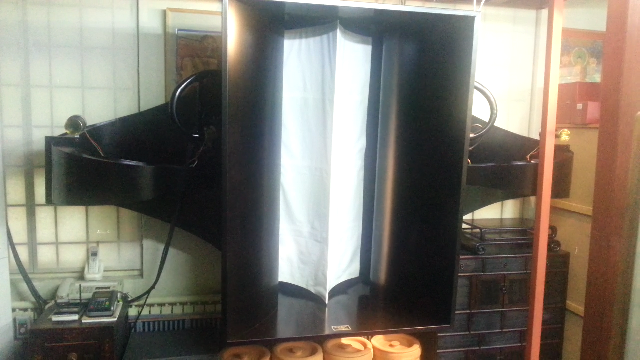
Western Electric 16A horn. This was used where there wasn’t enough space behind the screen to fit in a 15A system.
I hear that someone is making new replicas of these in Korea.
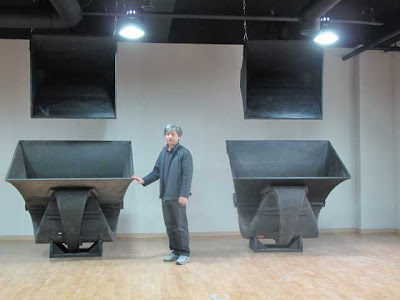
Western Electric 12A (top) and 13A (bottom) horns, from the Silbatone collection in Korea.
These treasures of prewar American Audio mostly ended up in Asia, while American audiophiles listen to overpriced shoebox speakers.
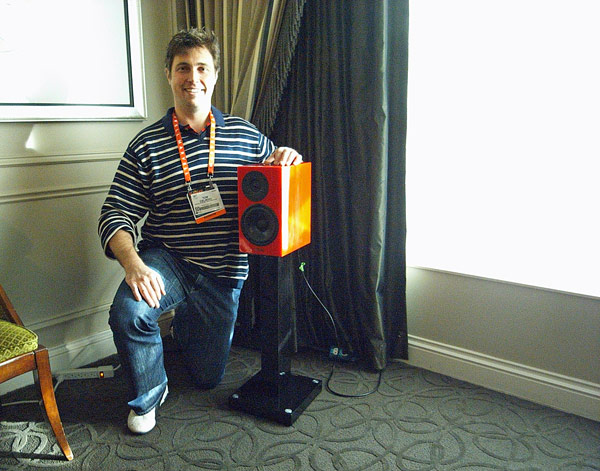
American audiophile circa 2014. Yeah baby yeah!
There’s a time and place for these little box speakers. If that fits your vision and ambition, just get a Spendor S3/5, and live happily ever after.
This stuff was perfected forty years ago. There’s nothing in this format that is much better. Seriously.
What I have here is somewhat like the less-well-known Western Mirrorphonic system, from the same era.
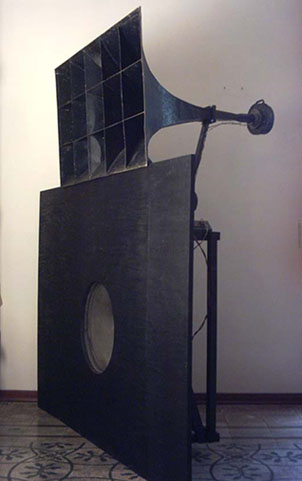
Mirrorphonic system, for smaller spaces.
Third, I can use these amazing vintage drivers, which have a tone and presentation that many become addicted to. The modern DCX50 is also reportedly very good, but there is a certain vintage/alnico/phenolic vibe that is a lot of fun. Like the classic wideband cone drivers, such as the Goodmans Axiom 80, or the Western Electric 755A. These are about soul and expression, not perfection.
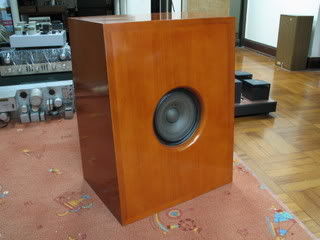
Western Electric 755A, from about 1948. Your basic 8″ wideband cone driver, in a box. If you went to public school in the 1950s, you might have heard one of these in the classroom PA system as you said the pledge of allegiance together. Yet, these are legendary today, particularly in Asia, and the other six hundred billion 8″ cone drivers made since 1948 are not.
Actually, I used a 755C for a while, which is nearly the same thing. Nice, but a little overrated.
Fourth, as round horns, they avoid many of the problems of radial or multicellular horns. I preferred these horns and drivers to the classic radial RCA MI-9595/MI-9584 combo and multicell Altec 1005/288 combo in side by side listening. But beamy. Very beamy. Nevertheless, that’s why most horn-loving audiophiles go for round horns today, typically of a tractrix or Le Cleach expansion.
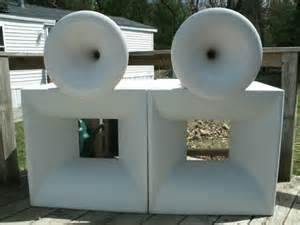
Typical DIY audiophile horn combo circa 2014. Round horns with a Le Cleach expansion, probably crossing around 500hz to a lower-midrange horn covering roughly 100-500hz with a 15″ cone driver (not installed). Also very beamy.
Actually, I hear that horn nut Jeffrey Jackson has been listening to a Goto 505 on his 140hz round horns, presumably wideband. Isn’t that interesting?
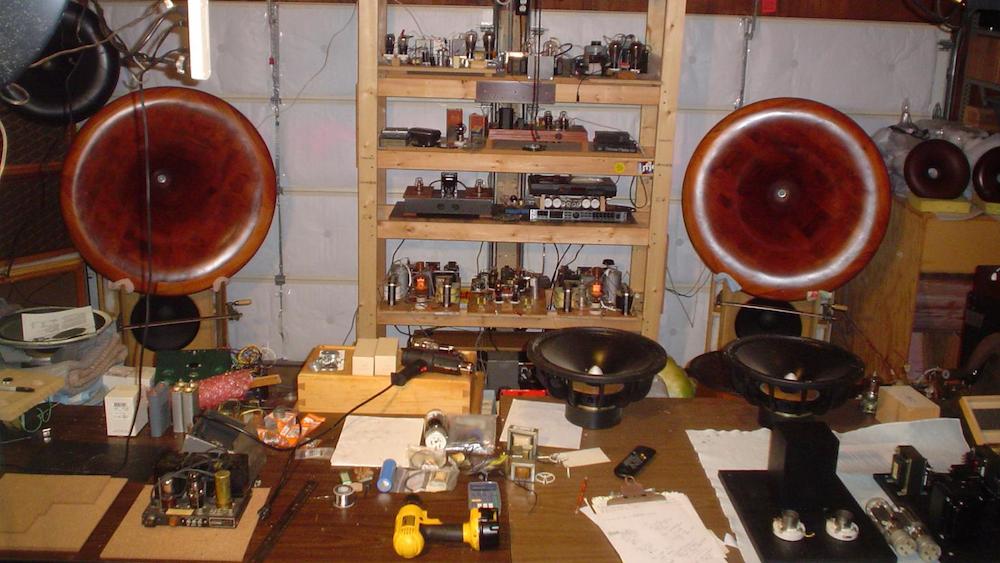
Jeffrey Jackson’s Goto 505 drivers on giant 140hz Le Cleach horns, 2011. These horns are 34″ wide, apparently being used wideband here. Note the cruddy little subwoofers below.
Which just goes to show that similar minds think similarly.
Jeffrey used to join us at Oswald’s Mill in the early 2000s, where we would listen to the RCA theater system from the 1950s, whose basshorns ended up in my loft.
Fifth, they just look crazy as all hell. Coolio!
Who wants to spend big $$ just to end up with a little rectangular box with some circle thingies?
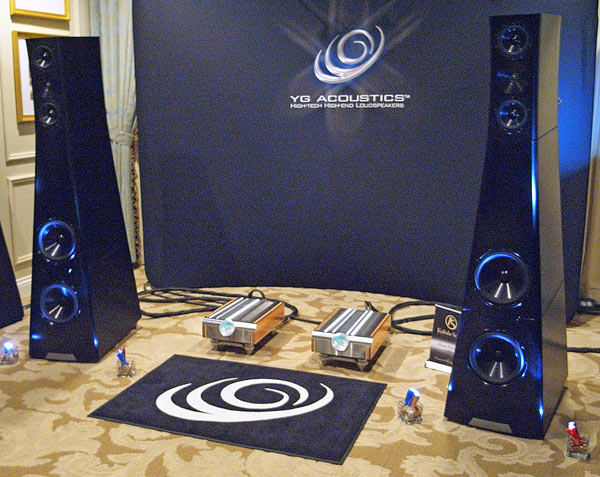
YG Acoustics Sonja 1.3 speakers. Your basic “monkey coffin” box with a 5″ cone midrange and 1″ dome tweeter, plus a little bass support.
$106,800.
Am I joking? No, but there’s a joke being played by someone …

Magico Q7. $185,000.
Ha ha. Ha ha ha.
You could get some replica 15As made, and some contemporary WE555 replicas from GIP in Japan, or even real WE555s, for a heck of a lot less than $185,000.
At first, all the quirkiness was a little tiresome. Over a few weeks, however, I sort of got used to it, and it didn’t bother me so much. I didn’t feel like I needed to keep my head still in one place, but would walk around the room and dance with the toddler, without going dizzy from all the soundfield changes.
I suppose I could put in another horn around 700hz or so, maybe the Altec 288s on a conical, which would clean up a lot of stuff and probably have a lot more “neutral” midrange without so many beamy/vintage/honky overtones. But, that would mean discarding all the one-driver wideband advantages. Nobody adds a midrange horn to a Western 15A system, and arguably the midrange is even more compromised there. So, I think it is best just as it is, in all of its vintage quirky glory. I just think of it as a mini-15A or Mirrorphonic sort of approach, and leave it at that.
These days, I am willing to have a lot of “technical problems” if the device nevertheless lets me hear in to the tone and emotion of the music. This setup is already pretty good for that, and it will get a lot better when I sort out the bass solution.
Unfortunately, it sounds good enough that it has–again–short-circuited my plans to do something more like the Imperia. One reason I set this up, I think, is because, before selling it to help fund my new horn project, I wanted to confirm that “it wasn’t really all that good compared to the Imperia.” Alas, that didn’t happen. Of course it isn’t as good but … it is good enough for now, for me, and has its own special charms, including the fact that it is set up and running right now. But, maybe that is good, because it’s better not to fuss with some major new horn project, and just listen to music instead. Actually, my headphones sound better in many ways, as one would expect as they don’t have all the difficulties of speakers. So, in a way, this is a sort of “fun” system, where I am willing to have a big list of “problems,” which are fine as long as it keeps a smile on my face.
And it does.
I hear that Art Dudley, once of Listener, actually lives not far from me. Once I get the bass finalized, I’ll invite him over.

